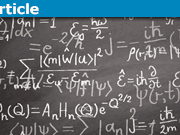A Classical View of the Qubit
This Insight article is part of my paper Foundations of quantum physics III. Measurement, featuring the thermal interpretation of quantum physics. See this discussion.
$$\def\D{\displaystyle} % display style
\def\SS {{\bf S}}
\def\Bsymbol#1{{\bm #1}}
\def\Bsigma{{\sigma}}
\def\half{\frac{1}{2}}
\def\<{\langle} % expectation
\def\>{\rangle} % expectation
\def\fct#1{\mathop{\rm #1}} % e.g., \fct{tr}
\def\fns#1{{\mbox{\rm \scriptsize#1}}} % subscript text
\def\Tr{{\fct{Tr}}}$$
Stokes’ quantum counter. One night, after a long day with fruitless discussions about getting a raise for the 1853 budget of his optical lab, Prof. Stokes had a strange dream. A hardly visible person appeared, placed a small box on his desk, and disappeared again, with the words: ”If you can find out how to measure the Stokes vector of a monochromatic beam of light using the device inside this box, next year’s budget will be doubled.” Pondering what had happened, Prof. Stokes woke up. To his surprise, he saw in the morning dusk a small box lying on his desk. He opened it and found a little gadget that we would easily recognize as an LED display — something completely unknown to Stokes –, a lens, and a button (and some invisible stuff inside the gadget). The display showed a 5 digit decimal integer, and every now and then, the number changed, increasing by one unit, at apparently random times. A counting device, he thought. He had never seen such a thing. Having become curious, he played with it. Putting his thumb upon the lens, the counting stopped. He pressed the button, and the counter displayed all zeros, then changed at erratic times to ##00001, 00002, 00003, \ldots##. He tried again and found that this pattern of behavior was repeatable. He opened the curtains to let more of the morning light in, and to his surprise, the numbers on the display increased at a somewhat more rapid pace. Very interesting, he thought, the counter is sensitive to the amount of light! Prof. Stokes remembered the words from his dream, ”find out how to use this device to measure …”, and began a systematic study of the counter behavior. He found that the rate of counting was roughly proportional to the intensity of the light, but because of the inherent randomness of the counting process, one needed to estimate the rate (and hence the intensity) from a sufficiently long interval of observation. Prof. Stokes felt like Archimedes in his bathtub. Heureka! At this moment his alarm clock rang, and Prof. Stokes woke up, noticing that he had another difficult round of budget negotiations coming up today…
It is commonly said that quantum mechanics originated in 1900 with Max Planck, reached its modern form with Werner Heisenberg and Erwin Schrödinger, got its correct interpretation with Max Born, and its modern mathematical formulation with Paul Dirac and John von Neumann.
It is very little known that much earlier – in 1852, at a time when Planck, Heisenberg, Schrödinger, Born, Dirac, and von Neumann were not even born -, George Stokes (known also for the Navier-Stokes equations of fluid mechanics and for Stokes’ theorem for integration over closed boundaries) described all the modern quantum phenomena of a single qubit, explaining them in classical terms. See the paper
G.G. Stokes, On the composition and resolution of streams of polarized light from different sources, Trans. Cambridge Phil. Soc. 9 (1852), 399–416. (Reprinted in: W. Swindell, Polarized light, Dowden 1975.)
Stokes’ description is coached in the language of optics — polarized light was the only quantum system that, at that time, was both accessible to experiment and quantitatively understood. Stokes’ classical observables are the functions of the components of the coherence matrix, the optical analog of the density operator of a qubit. (Remarkably, this description of a qubit is fully consistent with my
thermal interpretation of quantum physics, which asserts that the true quantum observables are the functions of the components of the density operator of a qubit!)
The transformation behavior of rays of completely polarized light was first described in 1809 by Etienne-Louis Malus (who coined the name ”polarization”); that of partially polarized light in 1852 by George Stokes The following is a modern description of the core of this work by Malus and Stokes.
We shall see that Stokes’ description of a polarized quasi-monochromatic beam of classical light behaves exactly like a modern quantum bit.
A ray (quasimonochromatic beam) of polarized light of fixed frequency is characterized by a state, described equivalently by a real Stokes vector
$$
S=(S_0,S_1,S_2,S_3)^T={S_0\choose \SS}
$$
with
$$
S_0\ge |\SS| = \sqrt{S_1^2+S_2^2+S_3^2},
$$
or by a coherence matrix, a complex positive semidefinite ##2\times 2## matrix ##\rho##. These are related by
$$
\D\rho = \half(S_0 + \SS \cdot\Bsigma)
=\half\pmatrix{S_0+S_3 & S_1-iS_2\cr S_1+iS_2 & S_0-S_3},
$$
where ##\Bsigma## is the vector of Pauli matrices. ##\Tr\rho=S_0## is the {\bf intensity} of the beam. ##p=|\SS|/S_0\in[0,1]## is the degree of polarization. Note the slight difference to density matrices, where the trace is required to be one.
A linear, non-mixing (not depolarizing) instrument (for example a polarizer or phase rotator) is characterized by a complex ##2\times 2## Jones matrix ##T##. The instrument transforms an in-going beam in the state ##\rho## into an out-going beam in the state ##\rho’=T\rho T^*##. The intensity of a beam after passing the instrument is ##S_0’=\Tr \rho’=\Tr T\rho T^*=\Tr \rho T^*T##. If the instrument is lossless, the intensities of the in-going and the out-going beam are identical. This is the case if and only if the Jones matrix ##T## is unitary.
Since ##\det\rho=(S_0^2-S_3^2)-(S_1^2+S_2)^2=S_0^2-\SS^2##, the fully polarized case ##p=1##, i.e., ##S_0=|\SS|##, is equivalent with ##\det\rho=0##, hence holds iff the rank of ##\rho## is ##0## or ##1##. In this case, the coherence matrix can be written in the form ##\rho=\psi\psi^*## with a state vector ##\psi## determined up to a phase. Thus precisely the pure states are fully polarized. In this case, the intensity of the beam is
$$
S_0=\<1\>=|\psi|^2=\psi^*\psi.
$$
A polarizer has ##T=\phi\phi^*##, where ##|\phi|^2=1##. It reduces the intensity to
$$
S_0’=\<T^*T\>=|\phi^*\psi|^2.
$$
This is Malus’ law.
An instrument with Jones matrix ##T## transforms a beam in the pure state ##\psi## into a beam in the pure state ##\psi’=T\psi##. Passage through inhomogeneous media can be modeled by means of many slices consisting of very thin instruments with Jones matrices ##T(t)## close to the identity. If ##\psi(t)## denotes the pure state at time ##t## then ##\psi(t+\Delta t) = T(t) \psi(t)##, so that for small ##\Delta t## (the time needed to pass through one slice),
$$
\frac{d}{dt}\psi(t)
= \frac{\psi(t+\Delta t)-\psi(t)}{\Delta t}+O(\Delta t)
= \frac{(T(t)-1)}{\Delta t} \psi(t)+O(\Delta t).
$$
In a continuum limit ##\Delta t\to 0## we obtain the time-dependent Schrödinger equation
$$
i\hbar\frac{d}{dt}\psi(t) = H(t) \psi(t),
$$
where (note that ##T(t)## depends on ##\Delta t##)
$$
H(t)=\lim_{\Delta t\to 0} i\hbar\frac{T(t)-1}{\Delta t}
$$
plays the role of a time-dependent Hamiltonian. Note that in the lossless case, ##T(t)## is unitary, hence ##H(t)## is Hermitian.
A linear, mixing (depolarizing) instrument transforms ##\rho## instead into a sum of several terms of the form ##T\rho T^*##. It is therefore described by a real ##4\times 4## Mueller matrix acting on the Stokes vector. Equivalently, it is described by a completely positive linear map on the space of ##2\times 2## matrices, acting on the polarization matrix.
Thus we see that a polarized quasi-monochromatic beam of classical light behaves exactly like a modern quantum bit. We might say that classical optics is just the quantum physics of a single qubit passing through a medium!
Indeed, the 1852 paper by Stokes described all the modern quantum phenomena for qubits, explained in classical terms. In particular,
- Splitting fully polarized beams into two such beams with different, but orthogonal polarization corresponds to writing a wave function as a superposition of preferred basis vectors.
- Mixed states are defined (in paragraph 9) as arising from ”groups of independent polarized streams” and give rise to partially polarized beams.
- The coherence matrix is represented by Stokes with four real parameters, in today’s terms comprising the Stokes vector.
- Stokes asserts (in his paragraph 16) the impossibility of recovering from a mixture of several distinct pure states any information about these states beyond what is encoded in the Stokes vector (equivalently, the coherence matrix).
- The latter can be linearly decomposed in many essentially distinct ways into a sum of pure states, but all these decompositions are optically indistinguishable, hence have no physical meaning.
The only difference to the modern description is that the microscopic view is missing. For faint light, photodetection leads to discrete detection events – even in models with an external classical electromagnetic field. The trace of ##\rho## is the intensity of the beam, and the rate of detection events is proportional to it. After normalization to unit intensity, ##\rho## becomes the density operator corresponding to a single detection event (aka photon).
This is a simple instance of the transition from a beam (classical optics or quantum field) description to a single particle (quantum mechanical) description.
It took 75 years after Stokes until the qubit made its next appearance in the literature, in a much less comprehensive way. In 1927, Weyl discusses qubits in the guise of an ensemble (”Schwarm”) of spinning electrons.
H. Weyl, Quantenmechanik und Gruppentheorie, Z. Phys. 46 (1927), 1–46.
Instead of the language of Stokes, Weyl’s description uses the paradoxical language still in use today, where the meaning of everything must be redefined to give at least the appearance of making sense.
In its modern formulation via Maxwell’s equations, classical partially polarized light (as described by Stokes) already requires the stochastic form of these equations, featuring – just like the full quantum description – field expectations and correlation functions. The coherence matrices turn into simple cases of classical matrix-valued field correlation functions.
Full Professor (Chair for Computational Mathematics) at the University of Vienna, Austria









I added a link to an online source for Stokes' 1852 paper on the subject.
Nice article. I never knew GG Stokes was such a visionary having described the Qubit before we put a name to it.